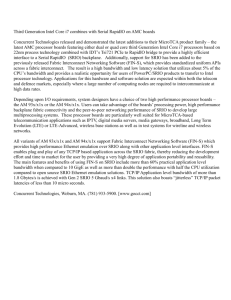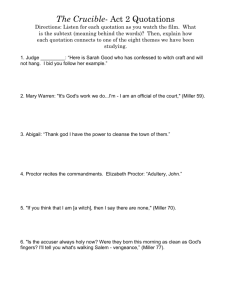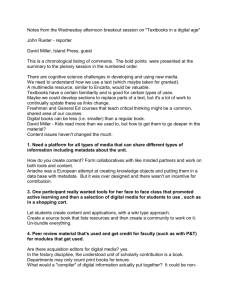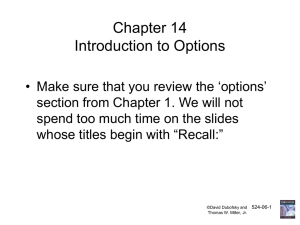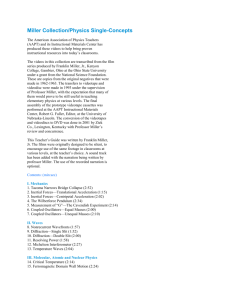Chapter 17
advertisement
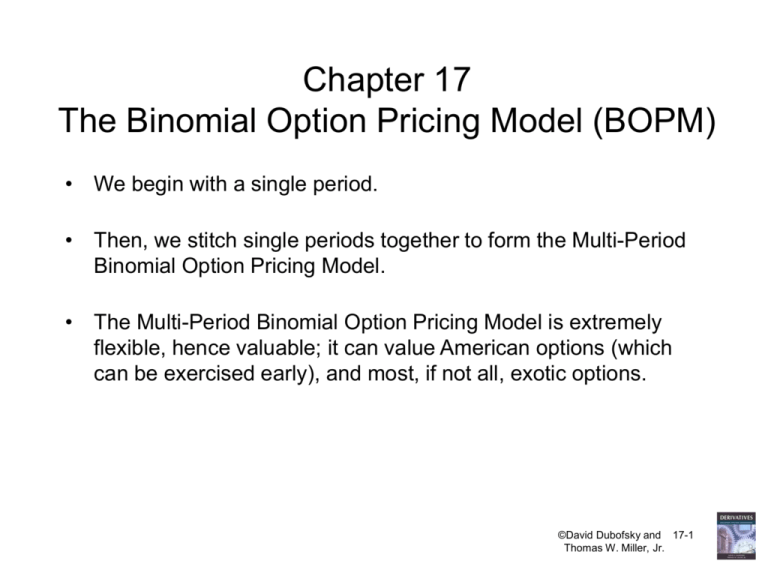
Chapter 17 The Binomial Option Pricing Model (BOPM) • We begin with a single period. • Then, we stitch single periods together to form the Multi-Period Binomial Option Pricing Model. • The Multi-Period Binomial Option Pricing Model is extremely flexible, hence valuable; it can value American options (which can be exercised early), and most, if not all, exotic options. ©David Dubofsky and 17-1 Thomas W. Miller, Jr. Assumptions of the BOPM • There are two (and only two) possible prices for the underlying asset on the next date. The underlying price will either: – Increase by a factor of u% (an uptick) – Decrease by a factor of d% (a downtick) • The uncertainty is that we do not know which of the two prices will be realized. • No dividends. • The one-period interest rate, r, is constant over the life of the option (r% per period). • Markets are perfect (no commissions, bid-ask spreads, taxes, price pressure, etc.) ©David Dubofsky and 17-2 Thomas W. Miller, Jr. The Stock Pricing ‘Process’ Time T is the expiration day of a call option. Time T-1 is one period prior to expiration. ST,u = (1+u)ST-1 ST-1 ST,d = (1+d)ST-1 Suppose that ST-1 = 40, u = 25% and d = -10%. What are ST,u and ST,d? ST,u = ______ 40 ST,d = ______ ©David Dubofsky and 17-3 Thomas W. Miller, Jr. The Option Pricing Process CT,u = max(0, ST,u-K) = max(0,(1+u)ST-1-K) CT-1 CT,d = max(0, ST,d-K) = max(0,(1+d)ST-1-K) Suppose that K = 45. What are CT,u and CT,d? CT,u = ______ CT-1 CT,d = ______ ©David Dubofsky and 17-4 Thomas W. Miller, Jr. The Equivalent Portfolio Buy shares of stock and borrow $B. (1+u)ST-1 + (1+r)B = ST,u + (1+r)B ST-1+B (1+d)ST-1 + (1+r)B = ST,d + (1+r)B NB: is not a “change” in S…. It defines the # of shares to buy. For a call, 0 < < 1 Set the payoffs of the equivalent portfolio equal to CT,u and CT,d, respectively. (1+u)ST-1 + (1+r)B = CT,u (1+d)ST-1 + (1+r)B = CT,d These are two equations with two unknowns: and B What are the two equations in the numerical example with ST-1 = 40, u = 25%, d = -10%, r = 5%, and K = 45? ©David Dubofsky and 17-5 Thomas W. Miller, Jr. A Key Point • If two assets offer the same payoffs at time T, then they must be priced the same at time T-1. • Here, we have set the problem up so that the equivalent portfolio offers the same payoffs as the call. • Hence the call’s value at time T-1 must equal the $ amount invested in the equivalent portfolio. CT-1 = ST-1 + B ©David Dubofsky and 17-6 Thomas W. Miller, Jr. and B define the “Equivalent Portfolio” of a call Δ B CT,u CT, d (u d)S T 1 CT,u CT, d S T,u S T, d (1 u)CT, d (1 d)CT,u (u d)(1 r) ; 0 Δ c 1 (17 - 1) ; Bc 0 (17 - 2) CT-1 = ST-1 + B NB: a negative sign now denotes borrowing! (17-5) Assume that the underlying asset can only rise by u% or decline by d% in the next period. Then in general, at any time: Δ Cu C d Cu C d (u d)S Su S d (17 - 3) B (1 u)C d (1 d)Cu (u d)(1 r) (17 - 4) C = S + B (17-6) ©David Dubofsky and 17-7 Thomas W. Miller, Jr. So, in the Numerical Example…. ST-1 = 40, u = 25%, ST,u = 50, d = -10%, ST,d = 36, r = 5%, K = 45, CT,u = 5 and CT,d = 0. What are the values of , B, and CT-1? What if CT-1 = 3? What if CT-1 = 1? ©David Dubofsky and 17-8 Thomas W. Miller, Jr. A Shortcut CT 1 r d ur CT, u C T, d ud ud (1 r) or, CT 1 pC T,u (1 p)C T, d (17 - 7) (1 r) where, p In general: r d ud C and (1 p) pCu (1 p)C d (1 r) ur ud (17 - 8) ©David Dubofsky and 17-9 Thomas W. Miller, Jr. Interpreting p r d p ud • p is the probability of an uptick in a risk-neutral world. • In a risk-neutral world, all assets (including the stock and the option) will be priced to provide the same riskless rate of return, r. • In our example, if p is the probability of an uptick then ST-1 = [(0.428571429)(50) + (0.571428571)(36)]/1.05 = 40 • That is, the stock is priced to provide the same riskless rate of return as the call option ©David Dubofsky and 17-10 Thomas W. Miller, Jr. Interpreting : • Delta, , is the riskless hedge ratio; 0 < c < 1. • Delta, , is the number of shares needed to hedge one call. I.e., if you are long one call, you can hedge your risk by selling shares of stock. • Therefore, the number of calls to hedge one share is 1/. I.e., if you own 100 shares of stock, then sell 1/ calls to hedge your position. Equivalently, buy shares of stock and write one call. • Delta is the slope of the lines shown in Figures 14.3 and 14.4 (where an option’s value is a function of the price of the underlying asset). • In continuous time, = ∂C/∂S = the change in the value of a call caused by a (small) change in the price of the underlying asset. ©David Dubofsky and 17-11 Thomas W. Miller, Jr. Two Period Binomial Model ST,uu = (1+u)2ST-2 ST-1,u = (1+u)ST-2 ST,ud = (1+u)(1+d)ST-2 ST-2 ST-1,d = (1+d)ST-2 ST,dd = (1+d)2ST-2 CT,uu = max[0,(1+u)2ST-2 - K] CT-1,u CT-2 CT-1,d CT,ud = max[0,(1+u)(1+d)ST-2 - K] CT,dd = max[0,(1+d)2ST-2 - K] ©David Dubofsky and 17-12 Thomas W. Miller, Jr. Two Period Binomial Model: An Example ST,uu = 69.444 ST-1,u = 55.556 ST,ud = 50 ST-2 = 44.444 ST-1,d = 40.00 ST,dd = 36 CT,uu = _______ CT-1,u = ____ CT,ud = 5 CT-2 CT-1,d = 2.0408 CT,dd = 0 ©David Dubofsky and 17-13 Thomas W. Miller, Jr. Two Period Binomial Model: The Equivalent Portfolio =1 B = -42.857143 = 0.6851312 B = -24.1566014 T-2 = 0.357142857 B = -12.24489796 T-1 Note that as S rises, also rises. As S declines, so does . Note that the equivalent portfolio is self financing. This means that the cost of any purchase of shares (due to a rise in ) is accompanied by an equivalent increase in required borrowing (B becomes more negative). Any sale of shares (due to a decline in ) is accompanied by an equivalent decrease in required borrowing (B becomes less negative). ©David Dubofsky and 17-14 Thomas W. Miller, Jr. The Multi-Period BOPM • We can find binomial option prices for any number of periods by using the following five steps: (1) Build a price “tree” for the underlying. (2) Calculate the possible option values in the last period (time T = expiration date) (3) Set up ALL possible riskless portfolios in the penultimate period (next to last period). (4) Calculate all possible option prices in the penultimate period. (5) Keep working back through the tree to “Today” (Time T-n in an n-period, (n+1)-date, model). ©David Dubofsky and 17-15 Thomas W. Miller, Jr. The ‘n’ Period Binomial Formula: If n = 3: CT 3 p3CT,uuu 3p 2 (1 p)CT,uud 3p(1 p)2 CT,udd (1 p)3 CT, ddd (1 r) 3 (17 - 15) The “binomial coefficient” computes the number of ways we can get j upticks in n periods: n n! j j! (n j)! Thus, the 3-period model can be written as: C T 3 1 (1 r)3 3 j p (1 p)3 j max[0, (1 u) j (1 d)3 j S T 3 K]. j 0 j 3 ©David Dubofsky and 17-16 Thomas W. Miller, Jr. The ‘n’ Period Binomial Formula: In general, the n-period model is: 1 C (1 r)n n j p (1 p)n j [(1 u) j (1 d)n j ST n K]. j a j n (17 17) Where “a” in the summation is the minimum number of up-ticks so that the call finishes in-the-money. ©David Dubofsky and 17-17 Thomas W. Miller, Jr. A Large Multi-period Lattice Suppose that N = 100 days. Let u = 0.01 and d = -0.008. S0 = 50 135.241 = 50*(1.01^100) 132.830 = 50*(1.01^99)*(.992^1) 130.463 = 50*(1.01^98)*(.992^2) 51.51505 51.005 50.59696 50.50 50.00 50.096 49.69523 49.60 49.2032 48.80957 . . . . 23.214 = 50*(1.01^2)*(.992^98) 22.801 = 50*(1.01^1)*(.992^99) 22.394 = 50*(.992^100) T=0 T=1 T=2 T=3 T=100 ©David Dubofsky and 17-18 Thomas W. Miller, Jr. Suppose the Number of Periods Approachs Infinity S T In the limit, that is, as N gets ‘large’, and if u and d are consistent with generating a lognormal distribution for ST, then the BOPM converges to the Black-Scholes Option Pricing Model (the BSOPM is the subject of Chapter 18). ©David Dubofsky and 17-19 Thomas W. Miller, Jr. Stocks Paying a Dollar Dividend Amount Figure 17.4: The stock trades exdividend ($1) at time T-2. Figure 17.5: The stock trades exdividend ($1) at time T-1. 25.410 25.520 23.100 22 => 21 24.20 => 23.20 21.945 20.040 22.000 19.950 20.000 21.890 18.9525 21.780 20.000 20.90 => 19.90 18.905 19.800 19.000 18.755 19 => 18 18.810 18.05 => 17.05 17.100 16.1975 16.245 T-3 T-2 T-1 T T-3 T-2 T-1 ©David Dubofsky and 17-20 Thomas W. Miller, Jr. T American Calls on Dividend Paying Stocks • The key is that at each “node” of the lattice, the value of an American call is: pCu (1 p)C d max , S K . (1 r) (17 19) If the first term in the brackets is less than the call’s intrinsic value, then you must instead value it as equal to its intrinsic value. Moreover, if the dividend amount paid in the next period exceeds K-PV(K), then the American call should be exercised early at that node. ©David Dubofsky and 17-21 Thomas W. Miller, Jr. Binomial Put Pricing - I PT,u = max(0,K-ST,u) = max(0,K-(1+u)ST-1) ST,u = (1+u)ST-1 ST-1 PT-1 PT,d = max(0,K-ST,d) = max(0,K-(1+d)ST-1) ST,d = (1+d)ST-1 (1+u)ST-1 + (1+r)B = ST,u + (1+r)B = PT,u ST-1+B (1+d)ST-1 + (1+r)B = ST,d + (1+r)B = PT,d ©David Dubofsky and 17-22 Thomas W. Miller, Jr. Binomial Put Pricing - II • PT-1 = ST-1 + B (17-24) Where: Δ Pu Pd P Pd u (u d)S Su Sd (17 22) B (1 u)Pd (1 d)Pu (u d)(1 r) (17 23) -1 < p < 0 B>0 A put is can be replicated by selling shares of stock short, and lending $B. and B change as time passes and as S changes. Thus, the equivalent portfolio must be adjusted as time passes. ©David Dubofsky and 17-23 Thomas W. Miller, Jr. Binomial Put Pricing - III pPu (1 p)Pd P (1 r) (17 26) Where: p r d ud and (1 p) ur ud ©David Dubofsky and 17-24 Thomas W. Miller, Jr. Binomial American Put Pricing pP (1 p)Pd P max K S, u (1 r) (17 27) At any node, if the 2nd term in the brackets is less than the American put’s intrinsic value, then value the put to equal its intrinsic value instead. American puts cannot sell for less than their intrinsic value. The American put will be exercised early at that node. ©David Dubofsky and 17-25 Thomas W. Miller, Jr. Binomial Put Pricing Example - I 79.86 The Stock Pricing Process: u = 10% d = -5% r = 2% K = 65 p = 0.466667 72.6 66 60 68.97 62.7 57 59.565 54.13 51.4425 T-3 T-2 T-1 ©David Dubofsky and 17-26 Thomas W. Miller, Jr. T Binomial Put Pricing Example - II European Put Values: 0 0 1.485924 3.9776 0 2.84183 6.306976 5.435 9.57549 13.5575 T-3 T-2 T-1 T ©David Dubofsky and 17-27 Thomas W. Miller, Jr. Binomial Put Pricing Example - III Composition of the equivalent portfolio to the European put: Δ = 0.0 B = 0.0 Δ = -0.2870535 B = 20.431458 Δ = -0.5356724 Δ = -0.5778841 B = 36.117946 B = 39.075163 Δ = -0.7875626 B = 51.198042 Δ = -1.0 B = 63.72549 T-3 T-2 T-1 ©David Dubofsky and 17-28 Thomas W. Miller, Jr. Binomial Put Pricing Example - IV American put pricing: If eqn. 17.25 yields an amount less than the put’s intrinsic value, then the American’s put value is K – S (shown in bold), and it should be exercised early. 0 0 1.485924 4.86284 0 2.84183 5 6.97339 5.435 8 9.57549 10 13.5575 T-3 T-2 T-1 ©David Dubofsky and 17-29 Thomas W. Miller, Jr. T
